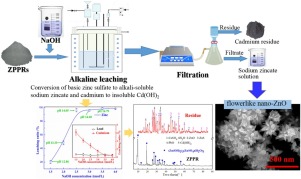当前位置:
X-MOL 学术
›
J. Hazard. Mater.
›
论文详情
Our official English website, www.x-mol.net, welcomes your
feedback! (Note: you will need to create a separate account there.)
A perspective of stepwise utilization of hazardous zinc plant purification residue based on selective alkaline leaching of zinc.
Journal of Hazardous Materials ( IF 12.2 ) Pub Date : 2020-01-14 , DOI: 10.1016/j.jhazmat.2020.122090 Yukun Huang 1 , Yangbo Geng 1 , Guihong Han 1 , Yijun Cao 1 , Weijun Peng 1 , Xiaofeng Zhu 2 , Ting-An Zhang 3 , Zhihe Dou 3
Journal of Hazardous Materials ( IF 12.2 ) Pub Date : 2020-01-14 , DOI: 10.1016/j.jhazmat.2020.122090 Yukun Huang 1 , Yangbo Geng 1 , Guihong Han 1 , Yijun Cao 1 , Weijun Peng 1 , Xiaofeng Zhu 2 , Ting-An Zhang 3 , Zhihe Dou 3
Affiliation

|
A new route for selective recovery of zinc from hazardous zinc plant purification residue was proposed by alkaline leaching process. The thermodynamic analysis revealed that by controlling solution pH in the range from 14.30 to 16.78 at 25 °C, basic zinc sulfate can be converted to ZnO22- instead of Zn(OH)2, while Cd will enter into alkaline leaching residue as a hydroxide. It is feasible to leach selectively Zn and to separate it with Cd by alkaline leaching, and the experimental results confirm that. Under the conditions of NaOH concentration of 3 mol/L, L/S of 20 ml/g, temperature of 40 °C, and time of 50 min, LR of Zn reached 96.14% while them of Pb and Cd were only 0.66% and 2.83% respectively. ZnO with hexagonal wurtzite structure and Cd(OH)2 were the main phases of leaching residue. They crystallized and adhered to the surface of leaching residue particles, which result in the loose and random particle morphology. The findings confirm that alkaline leaching is efficient in separation of Zn and Cd in ZPPR. In addition, nano-ZnO with flowerlike was synthesized with the zinc-rich leaching solution by precipitation method and the its photocatalytic property was similar to that of nano-ZnO purchased.
中文翻译:

基于锌的选择性碱浸法逐步利用危险的锌工厂纯化残留物的透视图。
提出了一种通过碱浸法从危险锌厂提纯残渣中选择性回收锌的新途径。热力学分析表明,通过在25°C下将溶液的pH控制在14.30至16.78之间,碱性硫酸锌可以转化为ZnO22-而不是Zn(OH)2,而Cd会以氢氧化物的形式进入碱性浸出残余物中。选择性浸出锌并通过碱浸分离镉与镉分离是可行的,实验结果证实了这一点。在NaOH浓度为3 mol / L,L / S为20 ml / g,温度为40°C,时间为50分钟的条件下,Zn的LR达到96.14%,而Pb和Cd的LR仅为0.66%。分别为2.83%。具有六方纤锌矿结构的ZnO和Cd(OH)2是浸出残余物的主要相。它们结晶并粘附到浸出的残留颗粒表面,这导致了松散且随机的颗粒形态。这些发现证实了碱性浸出法可有效分离ZPPR中的Zn和Cd。另外,利用富锌浸出液通过沉淀法合成了具有花状的纳米氧化锌,其光催化性能与所购纳米氧化锌相似。
更新日期:2020-01-14
中文翻译:

基于锌的选择性碱浸法逐步利用危险的锌工厂纯化残留物的透视图。
提出了一种通过碱浸法从危险锌厂提纯残渣中选择性回收锌的新途径。热力学分析表明,通过在25°C下将溶液的pH控制在14.30至16.78之间,碱性硫酸锌可以转化为ZnO22-而不是Zn(OH)2,而Cd会以氢氧化物的形式进入碱性浸出残余物中。选择性浸出锌并通过碱浸分离镉与镉分离是可行的,实验结果证实了这一点。在NaOH浓度为3 mol / L,L / S为20 ml / g,温度为40°C,时间为50分钟的条件下,Zn的LR达到96.14%,而Pb和Cd的LR仅为0.66%。分别为2.83%。具有六方纤锌矿结构的ZnO和Cd(OH)2是浸出残余物的主要相。它们结晶并粘附到浸出的残留颗粒表面,这导致了松散且随机的颗粒形态。这些发现证实了碱性浸出法可有效分离ZPPR中的Zn和Cd。另外,利用富锌浸出液通过沉淀法合成了具有花状的纳米氧化锌,其光催化性能与所购纳米氧化锌相似。











































 京公网安备 11010802027423号
京公网安备 11010802027423号